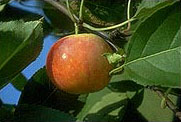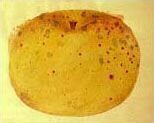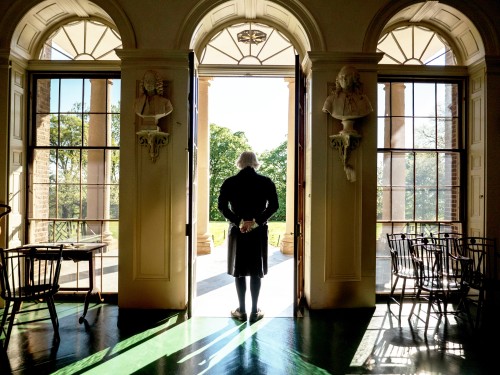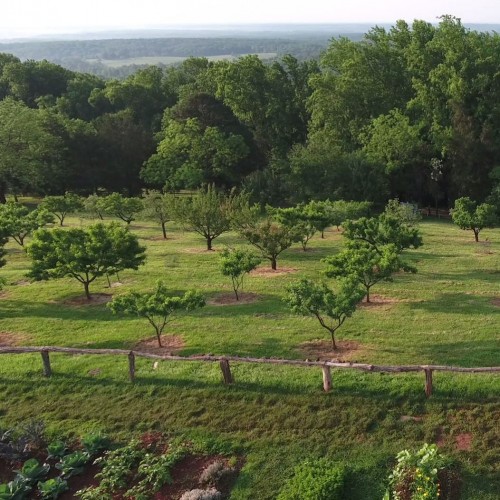Between 1769 and 1814 Jefferson planted as many as 1,031 fruit trees in his South Orchard. This orchard formed a horseshoe-shape around the two vineyards and berry squares. It was organized into a grid pattern in which he planted eighteen varieties of apple, thirty-eight of peach, fourteen cherry, twelve pear, twenty-seven plum, four nectarine, seven almond, six apricot, and a quince.
The earliest plantings, before 1780, reflect the experimental orchard of a young man eager to import Mediterranean culture to Virginia, and included olives, almonds, pomegranates, and figs. However, the mature plantings after 1810 included mostly species and varieties that either thrived through the hot, humid summers and cold, rainy winters of central Virginia, such as seedling late-season peaches or Virginia cider apples, or else, Jefferson's favorite fancy fruits like the Spitzenburg apple. Many of Jefferson's trials with European fruit varieties were unsuccessful. For example, while he planted two dozen plum varieties during his gardening career at Monticello, by the 1811 the orchard contained only two plum trees. The restoration of the South Orchard began in 1981. This pages contains information about the peaches, apples, cherries, and other fruit trees grown at Monticello.
Peaches
 Jefferson planted as many as thirty-eight varieties of peach in the South Orchard at a time when there were few cultivars available. In 1811 the orchard included 160 peach trees, far more than any other fruit. When Jefferson wrote his granddaughter in 1815 that "we abound in the luxury of the peach," he was reiterating a theme expressed by colonial fruit-growers and even the first natural historians of the New World. Although the peach tree is an oriental native, it was introduced into Florida in the sixteenth century and brought north by Indians. It escaped from gardens so readily that many early botanists were awed by the abundance of "wild" peaches throughout the Southeast. Peach orchards also thrived, partly because introduced insects and diseases had not spread enough to be a problem. Peaches were so prolific they were fed to the hogs.
Jefferson planted as many as thirty-eight varieties of peach in the South Orchard at a time when there were few cultivars available. In 1811 the orchard included 160 peach trees, far more than any other fruit. When Jefferson wrote his granddaughter in 1815 that "we abound in the luxury of the peach," he was reiterating a theme expressed by colonial fruit-growers and even the first natural historians of the New World. Although the peach tree is an oriental native, it was introduced into Florida in the sixteenth century and brought north by Indians. It escaped from gardens so readily that many early botanists were awed by the abundance of "wild" peaches throughout the Southeast. Peach orchards also thrived, partly because introduced insects and diseases had not spread enough to be a problem. Peaches were so prolific they were fed to the hogs.
Peaches were popular because they were easy to grow, trees bore fruit soon after planting, and they could be propagated simply from seed. Jefferson dried the fruit and also made mobby, a peach brandy common in Virginia. He planted thousands of peach trees alongside his fields as an ornamental fence and also envisioned this fast-growing tree as a forestry product to provide wood for his fireplaces. But Jefferson also tried to assemble a collection of peach varieties for the table: Heath Cling, Oldmixon Cling, Morris' Red Rareripe -- the first American peach varieties, and Italian peaches previously unknown in this country -- the Alberges, Vaga Loggia, and Apple.
Selected peach varieties at Monticello
- Indian Blood Cling
- Oldmixon Free Peach
- Lemon Cling Peach
- Heath Cling Peach
Apples
 Just as the peach represented the luxurious fertility of the New World, the apple came to symbolize the diversity of America's melting pot culture. One modern source listed the names of 17,000 apple varieties that appeared in nineteenth-century American publications. Hundreds of apples varieties were available to colonial Virginia gardeners, many of them cider apples, most well adapted to the region's warm, humid summers. Jefferson, however, concentrated on only four cultivars either unequalled for cider production (Hewes' Crab and Taliaferro) or unsurpassed as dessert fruits (Newtown Pippin and Esopus Spitzenburg).
Just as the peach represented the luxurious fertility of the New World, the apple came to symbolize the diversity of America's melting pot culture. One modern source listed the names of 17,000 apple varieties that appeared in nineteenth-century American publications. Hundreds of apples varieties were available to colonial Virginia gardeners, many of them cider apples, most well adapted to the region's warm, humid summers. Jefferson, however, concentrated on only four cultivars either unequalled for cider production (Hewes' Crab and Taliaferro) or unsurpassed as dessert fruits (Newtown Pippin and Esopus Spitzenburg).
 Drawing of the Hewe's Crab Apple
Drawing of the Hewe's Crab AppleThe Hewes' Crab was the most important horticultural cultivar in eighteenth-century Virginia. This small, maverick apple is perhaps a cross between the traditional apple of pomology and the native crabapple (Malus angustifolia) and thrived in Virginia when more northern or European apples failed. Crushing the juicy Hewes' Crab for cider was like "squeezing a wet sponge." The Taliaferro was Jefferson's favorite: "the best cyder apple existing . . . nearer to the silky Champagne than any other." Unfortunately, it has disappeared from cultivation and remains Monticello's mystery apple.
Selected apples varieties at Monticello
- Hewe's Crab Apple
- Albemarle Pippin Apple
- Esopus Spitzenburg Apple
- Roxbury Russet Apple
When comparing the fruits of Europe and America, Jefferson wrote from Paris, "They have no apple to compare with our Newtown Pippin." Known later as the Albemarle Pippin, this apple supported a large industry in Jefferson's home county (Albemarle County) based on export to England. Like the Pippin, the Spitzenburg originated in New York and ruled the nineteenth-century pomological charts when apples were often critically reviewed and competively rated.
Cherries
 The cherry was the South Orchard's third most prominent fruit tree. Unlike the two major fruits, the cherry was a culinary luxury that supplied a "precious refreshment" early in the season when few fruits were ripe. Jefferson admired the ornamental qualities of the cherry Monticello cherries and he continued an ancient European and enduring colonial Virginia tradition by planting trees decoratively along the "long walk" of the vegetable garden terrace. The Carnation was his favorite variety, "so superior to all others that no other deserves the name of cherry."
The cherry was the South Orchard's third most prominent fruit tree. Unlike the two major fruits, the cherry was a culinary luxury that supplied a "precious refreshment" early in the season when few fruits were ripe. Jefferson admired the ornamental qualities of the cherry Monticello cherries and he continued an ancient European and enduring colonial Virginia tradition by planting trees decoratively along the "long walk" of the vegetable garden terrace. The Carnation was his favorite variety, "so superior to all others that no other deserves the name of cherry."
Selected cherry varieties at Monticello
- 'Carnation' Cherry
- 'May Duke' Cherry
- Cornelian Cherry
- Montmorency Cherry
Other Fruit Trees
Insects, diseases, and a hot, humid climate unfavorable to most European fruit tree varieties hindered the successful cultivation of pears, plums, almonds, and apricots at Monticello. Nevertheless, Jefferson's enthusiasm for his experimental trials was reflected by his proclamations on superior fruit. The Seckel pear, which originated near Philadelphia, was the "finest pear I've tasted since I left France & equalled the best pear there." The Peach apricot, which he introduced from France, was "the finest fruit which grows in Europe" and the Marseilles fig was the "the finest fig I've ever seen." The celebrated Green Gage plum was planted in large quantities. Indeed, Jefferson's 130 varieties of fruit trees represented the finest cultivars available to an early nineteenth-century gardener.

